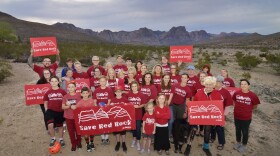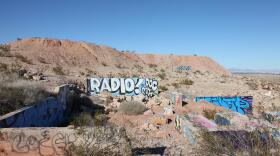Droll, odd, poignant, and awkward moments from the many Junes of Las Vegas history
June 1, 1972: While pondering a local hospital bill of $585.23 to remove a wart from a patient’s toe, the Nevada Consumers League questions the rapidly rising prices of hospitals and drug companies.
June 2, 2010: Given a two-game suspension for berating an umpire in the Junior College World Series, CSN’s 17-year-old baseball phenom Bryce Harper draws media attention to his “jerk-like” behavior.
June 3, 1956: Mayor C.D. Baker proclaims the radiant salmon-pink rose as our official flower to promote Las Vegas as “the Rose City of the Desert.”
June 4, 1952: Actress, feminist, and sex symbol Mae West plans to build a resort here, “Mae West’s Diamond Lil Casino,” across from the Flamingo.
June 5, 1972: Noting Nevada’s suicide, alcoholism, and crime rates are twice the national average, Dr. Donald Worpell, psychologist, reports that Vegas leads the nation “in the number of emotionally disturbed people.”
June 6, 1957: The 165 students of Rancho High School’s first graduating class receive their diplomas.
June 7, 1970: North Las Vegas Police Chief Nick Janise justifies his use of mace “on nearly 400 Rancho High students in a large-scale melee as the best means to stop them from killing each other.”
June 8, 2010: After being picked the previous day by the Washington Nationals, 17-year-old Bryce Harper “is the first native Las Vegan to be drafted No. 1 in any major professional sport.”
June 9, 1933: Officer Ernest May, 38, becomes the first Las Vegas police officer killed in the line of duty, when summoned, the previous evening, to the scene of “a drunken man shooting up the Clark Auto Court on South Fifth Street.” Ambushed and shot as he stepped out of his police car, the dying lawman returned fire, killing his assailant.
June 10, 1962: The fourth annual national convention of Gamblers Anonymous is in town.
June 11, 1982: At Caesars Palace, Larry Holmes successfully defends his world heavyweight boxing title against Gerry Cooney, upping his record to 40-0.
June 12, 1945: The film To Have and Have Not, based on Ernest Hemingway’s 1937 novel, starring Humphrey Bogart and Lauren Bacall, screenplay by William Faulkner, is playing at the Huntridge Theater.
June 13, 1956: Clark County Health Officer D.D. Carr reports a large supply of the Salk vaccine has arrived to protect area children from the nationwide deadly polio epidemic.
June 14, 1968: Arrested for “publishing matter inciting crimes,” a court date has been set for George French, 23, publisher of the underground Las Vegas Changing Times, “for his editorial encouraging the use of marijuana.”
June 15, 1855: Captain William Bringhurst arrives here after a monthlong trek from Salt Lake City “to start a Mormon settlement — an adobe enclosure called Fort Vegas.”
June 16, 2009: Embattled U.S. Sen. John Ensign, chairman of the Republican Policy Committee, and also an ardent fan of family values, publicly admits he has had an ongoing affair with one of his staff members, the wife of another one of his staff members.
June 17, 2008: Following the death of construction worker Lyndall Bates, 49, at Boyd Gaming Corp.’s Echelon project, the newspaper reports this is the 12th construction-related death on the Strip in the past 18 months.
June 18, 2009: Nevada’s unemployment reaches 11.3 percent, a state record.
June 19, 1992: Ten people die when a sightseeing flight from McCarran International Airport to the Grand Canyon crashes, raising the totals of similar flights in the previous 10 years to 13 crashes and 72 deaths.
June 20, 1961: In a speech at the Convention Center, with the temperature outside 114 degrees, former Vice President Richard Nixon jokes that he always enjoys the warmth he feels in Nevada, the state of his wife’s birth.
June 21, 1961: African-American protesters in San Francisco march against Nevadarama — “a travel agency there dealing only with Nevada reservations.” Protesters’ signs read: “Don’t support Nevada Jim Crow,” and “Nevada’s friendly — if you’re not a Negro.”
June 22, 1978: Attorney Oscar Goodman’s client, millionaire candy store magnate Lawrence Arvey, 38, convicted of raping a 9-year-old girl, skips bail and disappears.
June 23, 1992: After demonstrations by angry citizens, the school board finally relents “to build the first new grade school in Las Vegas’ predominantly black neighborhoods in over 20 years.”
June 24, 1957: Seventy-five brave pigs, dressed in military uniforms, sacrifice their lives in the latest atomic explosion at the Nevada Test Site, to determine the resilience of various fabrics when a nuclear bomb goes off.
June 25, 1957: Instead of pigs, 2,000 brave Marines have been selected to experience in close-up trenches, and in uniforms, next week’s atomic blast at the Test Site.
June 26, 1950: At 112 degrees in the shade, and no shade anywhere, the Polack Bros. Circus performs its two-hour matinee for 500 local kids at the Elks Stadium.
June 27, 1978: With 106 schools in the district, complaints start mounting as the school board still refuses to name one after a Jewish leader.
June 28, 1953: “Fourteen local cuties” compete for Miss Nevada at the Sands Hotel.
June 29, 1992: An earthquake in the Mojave Desert, registering 7.4 on the Richter scale, rattles buildings here, causing power outages.
June 30, 1935: On the grocery shelf, Grandpa’s Tar Soap is 17 cents for three bars.








